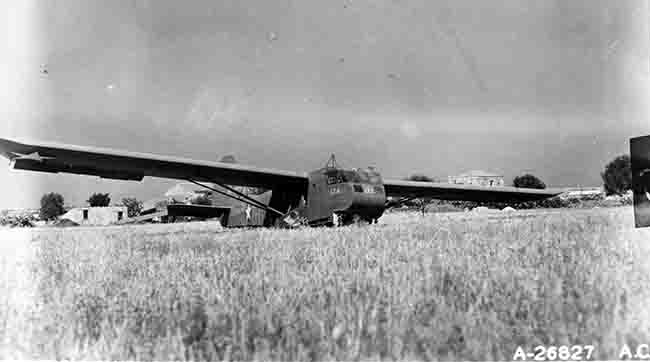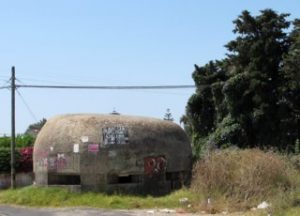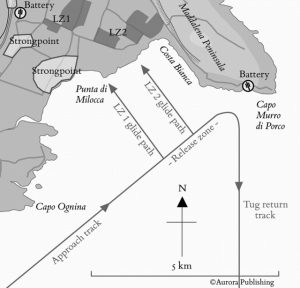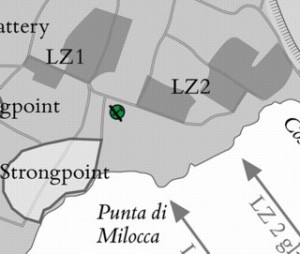Glider 126 made a good landing not far from the LZs, a rare occurrence in Operation Ladbroke. This is the story of the men who flew in her and fought for the Ponte Grande bridge.

Glider: CG-4A Waco 126, “Lil Miss-Take”, serial no. 377102.
Glider carrying: Part of Mortar Platoon, 1st Battalion of the Border Regiment.
Troops’ objective: Outskirts of Syracuse.
Manifest
1 sjt
1 ord
10 mortar men
1 A tk man
8 men R coy
5 trolleys
2 mortars
132 Bombs
This list has too many men (21) for one Waco (stated maximum capacity 13, excluding the glider pilots, although an extra three seats were added to many Wacos for this operation). Apparently the troops listed above were split between Glider 126 and Glider 126A, which does not have a manifest listed in the original document.
3″ mortars, even broken down into parts, plus mortar bombs in useful quantities, were heavy, and the men had up to 5 miles to go, mostly on dusty tracks. Some form of wheels was essential. Usually glider troops used the airborne handcart for this purpose, not the airborne trolley, which was designed for use by paratroopers, as it could be folded into parachute supply containers. Perhaps there were not enough handcarts to go around, so the platoon was given five trolleys instead.
RAF Tug Pilot’s Report
Tug: Albemarle, letter AB, number P1470, 296 Squadron, 38 Wing RAF.
Takeoff: 2006 hrs (9 mins late), Airstrip F, Goubrine No. 1, Tunisia. Priority 2.
Tug return: 0210 hrs (50 mins late).
Pilot Officer Wylie: Released at 2252 hrs at 1400 ft.
“Glider released successfully slightly overshot LZ. Struck by .303 bullets, visibility not good. Everything O.K.”
A separate report clarifies that it was the tug, not the glider, that was struck by rifle calibre bullets. This is odd, as the aircraft was presumably way out over the bay, out of the range of Italian small calibre weapons. Some machine guns may have been in tobruks (open-topped concrete or rock emplacements), but mainly they equipped the standard roofed pillboxes on the coast, and these were not well suited to anti-aircraft defence. Yet another report says that an Albemarle gave support to its glider after release by shooting at an Italian searchlight. Perhaps Wylie’s plane was hit in the darkness by stray British bullets.
Glider Pilots’ Report
Glider allotted Landing Zone: LZ 2.
Glider Pilots: S/Sgt Chandler & S/Sgt Torrance
“Good tow, intercomn failed after 10 mins flight. Glider released at 2310 hours at 1600 ft about 1/2 way across bay between PUNTA DI MILOCCA and MURRO DI PORCO and landed about 1 mile S.W. of L.Z. No casualties but undercarriage came through floor.”
Interestingly, the tug and glider pilots’ reports differ significantly on release time and height. 18 minutes is a lot, for men who had presumably synchronised watches just before take off. As for the height, for many a glider 200 feet was enough to make the difference between landing in the sea or on land, i.e. life and death. Some Wacos had trouble with their altimeters, which registered too high, but a 200 foot margin still seems excessive.
Landing
Glider 126 landed in a flat, open, stubble field only 300 yards from the south-west corner of LZ 2. It made one of the best landings of the night, close to its LZ and essentially intact. It lost its left wheel completely, possibly ripped off in a heavy landing caused by the altimeter reading being wrong. The loss of the wheel made the glider pivot 90 degrees left. A later examination reported that its right wheel ended up in a ditch, presumably bringing the Waco to an abrupt halt. Another glider, Glider 26, carrying a surgical team under Captain Rigby-Jones, landed only 100 yards away, next to a farm outbuilding. There was a large pillbox behind barbed wire 400 yards to the south of Glider 126.
Narrative
The other half of the mortar platoon, which was in Glider 126a, never arrived. It developed aileron trouble in Africa and released near its own airfield. It damaged its undercarriage in doing so, presumably by landing in the rough.

Not much is known about what happened to the men of Glider 126 after they landed in Sicily. The glider would have made a perfect target for the pillbox only 400 yards away, so perhaps the men were machine-gunned as they disembarked. Glider pilot S/Sgt Jimmy Fairgrieve (of Glider 25) said he saw the First Pilot of Glider 126, S/Sgt Chandler, at the Ponte Grande bridge.
Since Chandler reached the bridge, it’s possible that the rest of the men in Glider 126 also reached it, probably after dawn. Perhaps they were able to lug their 3″ mortar to the Ponte Grande – a mortar was a key part of the defence of the bridge until it ran out of ammunition. If they did reach the bridge, many of the Glider 126 men were probably killed or wounded, as only a dozen or so unwounded men were left out of over 80 when the glider men surrendered to the Italians.
Fairgrieve and Chandler were part of a small group of glider men who hid in a ditch after most of the surviving airborne troops had surrendered to the Italians. According to Fairgrieve, the men were looking ‘glum’. This seems a classic piece of period British understatement – these days the word would probably be ‘gutted’. The men managed to evade capture.
The Site Today
Until only a few years ago the scene was almost unchanged since the time of Operation Ladbroke. Now extensive building of new houses and roads, plus new farming techniques, has changed the look dramatically. The farm is still there, but whenever I have passed the field it has usually been covered with plastic tunnels instead of stubble (the farm is private and did not welcome my curiosity when I knocked). The fine-looking house in the right background of the photograph is now the Hotel Villa Fanusa, named after the area and the nearby beach. The pillbox is still there, and an electricity substation in a small tower that was present in 1943 completes the picture. (Observations accurate at the time they were made, although things may since have changed).
.
For other in-depth stories about individual gliders in Operation Ladbroke, click here.



The Story of Glider No.125 – piloted by my father, Sgt. John Thorne Braybrooks is told in some detail in Mike Peters book on Sicily. I cannot add anything further other than he wished that the glider pilots should not have been blamed as they were for the operation.
In his case it was the Albermarle tug that let him down. This event in itself could have ended in disaster.
Thanks David. The account in Mike Peters book is indeed detailed, but differs in some respects from the 38 Wing RAF and 1 Air Landing Brigade debriefings (the latter appears on page 290). These say the glider pilot was dazzled by the sun and landed heavily. The former says that the glider landed outside the airfield. Another account says that your father in fact reached Sicily and fought at the Ponte Grande bridge. The account appeared in the Eagle, the GPR magazine, in 1953, on the 10th anniversary of Operation Ladbroke. It was by an authoritative source, Capt Boucher-Giles, who had commanded the glider pilots defending the bridge. He specifically mentions “Braybrooks” as being with him. However there is little doubt 125 failed to leave Africa – there’s even a photograph of the 38 Wing ops board on the night, with “Engine trouble. Glider crashed” chalked against it. The only other possibility is that the glider pilot list is wrong in attributing your father as the pilot of 125. Alec Waldron, pilot of 119 and GPR intelligence officer at the time, says the list has at least one error, and so is not infallible. Nevertheless it seems Boucher-Giles misremembered, but it’s an intriguing thought. You probably already know that your father’s obituary appeared in the Eagle magazine, although it has no details of Operation Ladbroke. I discuss the blaming of the glider pilots here.
Many Thanks Ian.
I am scanning the page from the log book that I have here and will send to you via email to show the entry in Dad’s handwriting.
Thanks David. Your father’s logbook records a flight of only 50 minutes and a note reads: “Forced to return to base by tow A/C engine oil leak”. I would say that clinches it. I wonder who Boucher-Giles was actually thinking of when he named your father as being at the bridge.